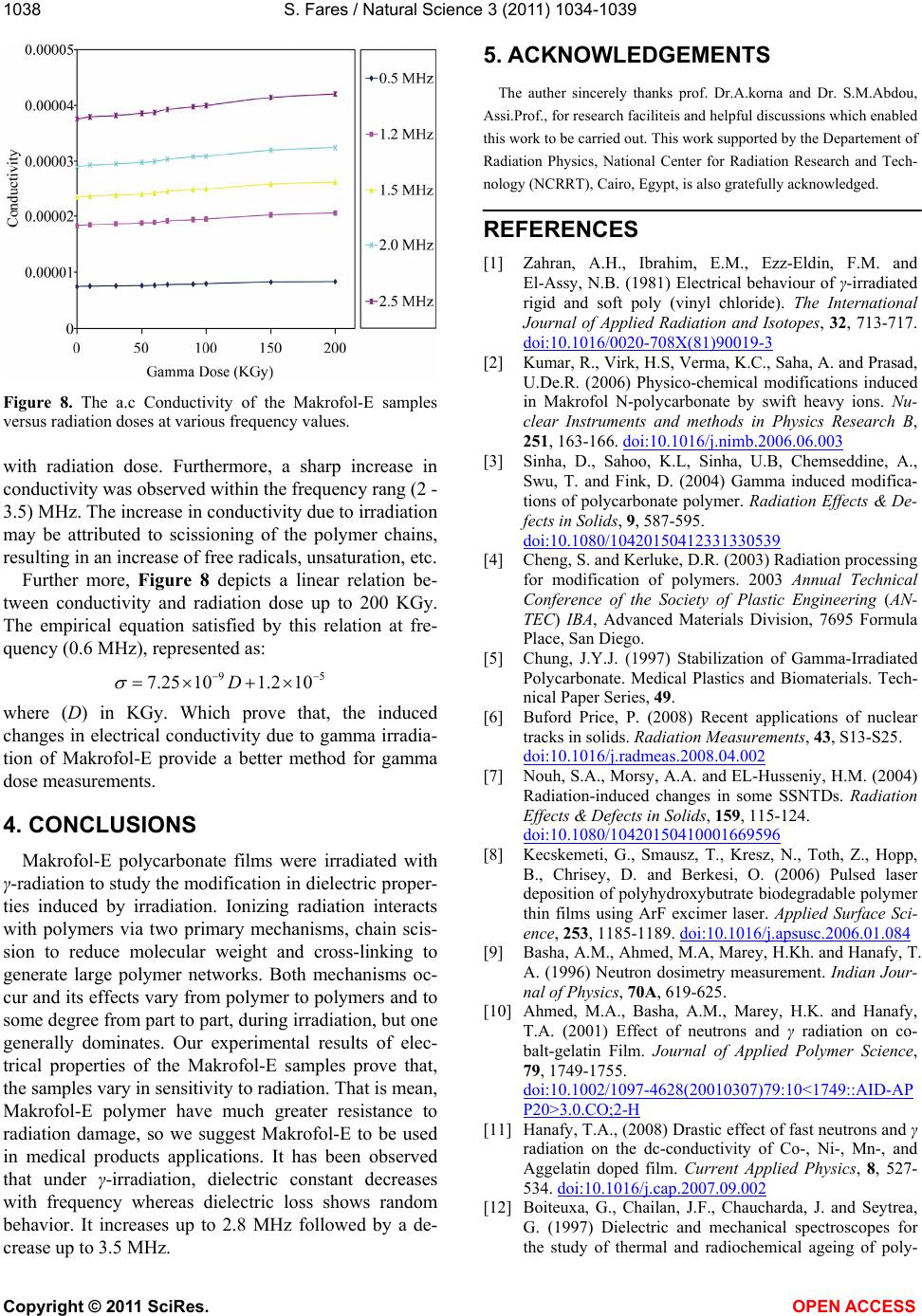
S. Fares / Natural Science 3 (2011) 1034-1039
Copyright © 2011 SciRes. OPEN ACCESS
1038
Figure 8. The a.c Conductivity of the Makrofol-E samples
versus radiation doses at various frequency values.
with radiation dose. Furthermore, a sharp increase in
conductivity was observed within the frequency rang (2 -
3.5) MHz. The increase in conductivity due to irradiation
may be attributed to scissioning of the polymer chains,
resulting in an increase of free radicals, unsaturation, etc.
Further more, Figure 8 depicts a linear relation be-
tween conductivity and radiation dose up to 200 KGy.
The empirical equation satisfied by this relation at fre-
quency (0.6 MHz), represented as:
95
7.25 101.2 10D
where (D) in KGy. Which prove that, the induced
changes in electrical conductivity due to gamma irradia-
tion of Makrofol-E provide a better method for gamma
dose measurements.
4. CONCLUSIONS
Makrofol-E polycarbonate films were irradiated with
γ-radiation to study the modification in dielectric proper-
ties induced by irradiation. Ionizing radiation interacts
with polymers via two primary mechanisms, chain scis-
sion to reduce molecular weight and cross-linking to
generate large polymer networks. Both mechanisms oc-
cur and its effects vary from polymer to polymers and to
some degree from part to part, during irradiation, but one
generally dominates. Our experimental results of elec-
trical properties of the Makrofol-E samples prove that,
the samples vary in sensitivity to radiation. That is mean,
Makrofol-E polymer have much greater resistance to
radiation damage, so we suggest Makrofol-E to be used
in medical products applications. It has been observed
that under γ-irradiation, dielectric constant decreases
with frequency whereas dielectric loss shows random
behavior. It increases up to 2.8 MHz followed by a de-
crease up to 3.5 MHz.
5. ACKNOWLEDGEMENTS
The auther sincerely thanks prof. Dr.A.korna and Dr. S.M.Abdou,
Assi.Prof., for research faciliteis and helpful discussions which enabled
this work to be carried out. This work supported by the Departement of
Radiation Physics, National Center for Radiation Research and Tech-
nology (NCRRT), Cairo, Egypt, is also gratefully acknowledged.
REFERENCES
[1] Zahran, A.H., Ibrahim, E.M., Ezz-Eldin, F.M. and
El-Assy, N.B. (1981) Electrical behaviour of γ-irradiated
rigid and soft poly (vinyl chloride). The International
Journal of Applied Radiation and Isotopes, 32, 713-717.
doi:10.1016/0020-708X(81)90019-3
[2] Kumar, R., Virk, H.S, Verma, K.C., Saha, A. and Prasad,
U.De.R. (2006) Physico-chemical modifications induced
in Makrofol N-polycarbonate by swift heavy ions. Nu-
clear Instruments and methods in Physics Research B,
251, 163-166. doi:10.1016/j.nimb.2006.06.003
[3] Sinha, D., Sahoo, K.L, Sinha, U.B, Chemseddine, A.,
Swu, T. and Fink, D. (2004) Gamma induced modifica-
tions of polycarbonate polymer. Radiation Effects & De-
fects in Solids, 9, 587-595.
doi:10.1080/10420150412331330539
[4] Cheng, S. and Kerluke, D.R. (2003) Radiation processing
for modification of polymers. 2003 Annual Technical
Conference of the Society of Plastic Engineering (AN-
TEC) IBA, Advanced Materials Division, 7695 Formula
Place, San Diego.
[5] Chung, J.Y.J. (1997) Stabilization of Gamma-Irradiated
Polycarbonate. Medical Plastics and Biomaterials. Tech-
nical Paper Series, 49.
[6] Buford Price, P. (2008) Recent applications of nuclear
tracks in solids. Radiation Measurements, 43, S13-S25.
doi:10.1016/j.radmeas.2008.04.002
[7] Nouh, S.A., Morsy, A.A. and EL-Husseniy, H.M. (2004)
Radiation-induced changes in some SSNTDs. Radiation
Effects & Defects in Solids, 159, 115-124.
doi:10.1080/10420150410001669596
[8] Kecskemeti, G., Smausz, T., Kresz, N., Toth, Z., Hopp,
B., Chrisey, D. and Berkesi, O. (2006) Pulsed laser
deposition of polyhydroxybutrate biodegradable polymer
thin films using ArF excimer laser. Applied Surface Sci-
ence, 253, 1185-1189. doi:10.1016/j.apsusc.2006.01.084
[9] Basha, A.M., Ahmed, M.A, Marey, H.Kh. and Hanafy, T.
A. (1996) Neutron dosimetry measurement. Indian Jour-
nal of Physics, 70A, 619-625.
[10] Ahmed, M.A., Basha, A.M., Marey, H.K. and Hanafy,
T.A. (2001) Effect of neutrons and γ radiation on co-
balt-gelatin Film. Journal of Applied Polymer Science,
79, 1749-1755.
doi:10.1002/1097-4628(20010307)79:10<1749::AID-AP
P20>3.0.CO;2-H
[11] Hanafy, T.A., (2008) Drastic effect of fast neutrons and γ
radiation on the dc-conductivity of Co-, Ni-, Mn-, and
Aggelatin doped film. Current Applied Physics, 8, 527-
534. doi:10.1016/j.cap.2007.09.002
[12] Boiteuxa, G., Chailan, J.F., Chaucharda, J. and Seytrea,
G. (1997) Dielectric and mechanical spectroscopes for
the study of thermal and radiochemical ageing of poly-